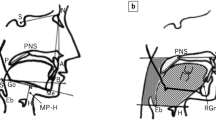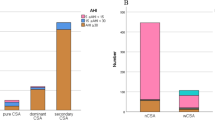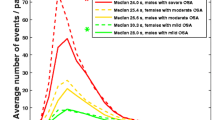Abstract
Purpose
Obstructive sleep apnea (OSA) is complicated with heart failure (HF); however, the reason for this is not well understood. Craniofacial anatomic risk factors may contribute to OSA pathogenesis in HF patients. However, there are no data about cephalometric findings among OSA patients with HF.
Methods
Consecutive patients with HF and OSA (defined as total apnea–hypopnea index (AHI) ≥15/h) were enrolled. As controls, OSA patients without HF but matching the test group in age, BMI, and obstructive AHI were also enrolled.
Results
Overall, 17 OSA patients with HF and 34 OSA patients without HF were compared. There are no significant differences in the characteristics or polysomnographic parameters between 2 groups. In the cephalometric findings, compared with patients without HF, patients with HF showed a significantly greater angle between the line SN to point “A” (SNA) and a longer inferior airway space and greater airway area. However, the tongue area of patients with HF was more than those without HF.
Conclusions
The craniofacial structures of OSA patients with HF were different from those without HF. OSA patients with HF had an upper airway anatomy that is more likely to collapse when sleeping while recumbent, despite having a larger airway space.


Similar content being viewed by others
References
White DP, Younes MK (2012) Obstructive sleep apnea. Compr Physiol 2(4):2541–2594
Isono S (2012) Obesity and obstructive sleep apnoea: mechanisms for increased collapsibility of the passive pharyngeal airway. Respirology 17(1):32–42
Ryan CM, Bradley TD (2005) Pathogenesis of obstructive sleep apnea. J Appl Physiol 99(6):2440–2450
Young T, Palta M, Dempsey J, Skatrud J, Weber S, Badr S (1993) The occurrence of sleep-disordered breathing among middle-aged adults. N Engl J Med 328(17):1230–1235
Shahar E, Whitney CW, Redline S, Lee ET, Newman AB, Javier Nieto F, O’Connor GT, Boland LL, Schwartz JE, Samet JM (2001) Sleep-disordered breathing and cardiovascular disease: cross-sectional results of the Sleep Heart Health Study. Am J Respir Crit Care Med 163(1):19–25
Ferrier K, Campbell A, Yee B, Richards M, O’Meeghan T, Weatherall M, Neill A (2005) Sleep-disordered breathing occurs frequently in stable outpatients with congestive heart failure. Chest 128(4):2116–2122
Javaheri S (2006) Sleep disorders in systolic heart failure: a prospective study of 100 male patients. The final report. Int J Cardiol 106(1):21–28
Vazir A, Hastings PC, Dayer M, McIntyre HF, Henein MY, Poole-Wilson PA, Cowie MR, Morrell MJ, Simonds AK (2007) A high prevalence of sleep disordered breathing in men with mild symptomatic chronic heart failure due to left ventricular systolic dysfunction. Eur J Heart Fail 9(3):243–250
Yumino D, Wang H, Floras JS, Newton GE, Mak S, Ruttanaumpawan P, Parker JD, Bradley TD (2009) Prevalence and physiological predictors of sleep apnea in patients with heart failure and systolic dysfunction. J Card Fail 15(4):279–285
Arzt M, Young T, Finn L, Skatrud JB, Ryan CM, Newton GE, Mak S, Parker JD, Floras JS, Bradley TD (2006) Sleepiness and sleep in patients with both systolic heart failure and obstructive sleep apnea. Arch Intern Med 166(16):1716–1722
Cistulli PA (1996) Craniofacial abnormalities in obstructive sleep apnoea: implications for treatment. Respirology 1(3):167–174
Sutherland K, Lee RW, Cistulli PA (2012) Obesity and craniofacial structure as risk factors for obstructive sleep apnoea: impact of ethnicity. Respirology 17(2):213–222
Johal A, Patel SI, Battagel JM (2007) The relationship between craniofacial anatomy and obstructive sleep apnea: a case–controlled study. J Sleep Res 16(3):319–326
Yu X, Fujimoto K, Urushibata K, Matsuzawa Y, Kubo K (2003) Cephalometric analysis in obese and nonobese patients with obstructive sleep apnea syndrome. Chest 124(1):212–218
Sakakibara H, Tong M, Matsushita K, Hirata M, Konishi Y, Suetsugu S (1999) Cephalometric abnormalities in non-obese and obese patients with obstructive sleep apnoea. Eur Respir J 13(2):403–410
Matsuo A, Inoue Y, Tsuiki S, Enomoto M, Namba K, Chiba H (2010) Clinical characteristics of Japanese patients with familial obstructive sleep apnoea syndrome. Respirology 15(1):93–98
Wasicko MJ, Hutt DA, Parisi RA, Neubauer JA, Mezrich R, Edelman NH (1990) The role of vascular tone in the control of upper airway collapsibility. Am Rev Respir Dis 141(6):1569–1577
Wasicko MJ, Leiter JC, Erlichman JS, Strobel RJ, Bartlett D Jr (1991) Nasal and pharyngeal resistance after topical mucosal vasoconstriction in normal humans. Am Rev Respir Dis 144(5):1048–1052
Berry RB, Brooks R, Gamaldo CE, Harding SM, Lloyd RM, Marcus CL, Vaughn BV (2013) The AASM Manual for the Scoring of Sleep and Associated Events: Rules, Terminology and Technical Specifications, Version 2.0.2. American Academy of Sleep Medicine, Darien, Illinois
Berry RB (2003) Sleep medicine pearls. The pearls series, 2nd edn. Hanley & Belfus, Philadelphia
Tsuiki S, Isono S, Ishikawa T, Yamashiro Y, Tatsumi K, Nishino T (2008) Anatomical balance of the upper airway and obstructive sleep apnea. Anesthesiology 108(6):1009–1015
Smith TJ, Bahn RS, Gorman CA (1989) Connective tissue, glycosaminoglycans, and diseases of the thyroid. Endocr Rev 10(3):366–391
Cohen AS, Calkins E (1959) Electron microscopic observations on a fibrous component in amyloid of diverse origins. Nature 183(4669):1202–1203
Schwab RJ, Gupta KB, Gefter WB, Metzger LJ, Hoffman EA, Pack AI (1995) Upper airway and soft tissue anatomy in normal subjects and patients with sleep-disordered breathing: significance of the lateral pharyngeal walls. Am J Respir Crit Care Med 152(5 Pt 1):1673–1689
Yumino D, Redolfi S, Ruttanaumpawan P, Su MC, Smith S, Newton GE, Mak S, Bradley TD (2010) Nocturnal rostral fluid shift: a unifying concept for the pathogenesis of obstructive and central sleep apnea in men with heart failure. Circulation 121(14):1598–1605
Kasai T, Floras JS, Bradley TD (2012) Sleep apnea and cardiovascular disease: a bidirectional relationship. Circulation 126(12):1495–1510
Li KK, Powell NB, Kushida C, Riley RW, Adornato B, Guilleminault C (1999) A comparison of Asian and white patients with obstructive sleep apnea syndrome. Laryngoscope 109(12):1937–1940
Li KK, Kushida C, Powell NB, Riley RW, Guilleminault C (2000) Obstructive sleep apnea syndrome: a comparison between Far-East Asian and white men. Laryngoscope 110(10 Pt 1):1689–1693
Jamieson A, Guilleminault C, Partinen M, Quera-Salva MA (1986) Obstructive sleep apneic patients have craniomandibular abnormalities. Sleep 9(4):469–477
Acknowledgments
This study was supported by the Research grants from the Okinaka Memorial Institute for Medical Research.
Funding
Research grants from the Okinaka Memorial Institute for Medical Research.
Conflicts of interest
None to declare
Author information
Authors and Affiliations
Corresponding author
Rights and permissions
About this article
Cite this article
Inoshita, A., Kasai, T., Takahashi, M. et al. Craniofacial anatomical risk factors in men with obstructive sleep apnea and heart failure: a pilot study. Sleep Breath 18, 439–445 (2014). https://doi.org/10.1007/s11325-013-0906-4
Received:
Revised:
Accepted:
Published:
Issue Date:
DOI: https://doi.org/10.1007/s11325-013-0906-4




